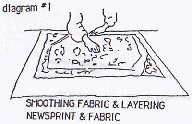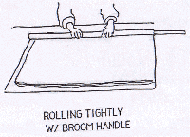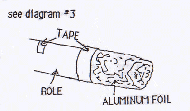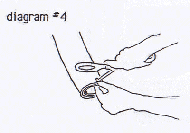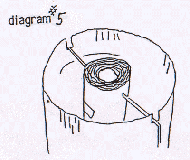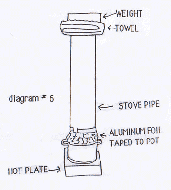Also see our Stovetop Steamer Instructions
Advantages of steaming:
- Economical #1 - No other fixative or chemicals to buy
- Economical #2 - Less dye is used than with other methods
- Environmentally safe - Nothing in the air or down the drain
- Predictable results
- Incredible color yield & intensity is achieved
- Quantities of smaller pieces can be steamed at one time
Materials for Steamer:
- Galvanized stove pipe, 8" diameter - 2' to 6' long (get this at building supplies, hardware stores, etc.)
- Hot plate
- Heavy weight pot
- Wire cutter (to cut clothes hanger)
- Weight (hunk of wood, old phone book, iron fry pan, anything will do)
Supplies for steaming:
- Dyed fabric - silk, cotton, rayon, etc.
- Clean newsprint (not colored ink or glossy print)
- Heavy aluminum foil
- Masking tape
- Thick towel
It is a good idea to practice steam setting with a scrap piece before doing an actual piece.
1. On work surface lay 3 layers of clean newsprint. Next lay the fabric on the paper with 2" allowance all around. Be sure to smooth out any wrinkles. Then place 3 more sheets of paper on top of the fabric. If placing fabrics side by side be sure they don't touch each other (at lease 2" apart). Keep layering until you think when it's tightly rolled it will be no larger then 6" diameter.
2. Start rolling into a tube. This is made easer by using a small diameter pole (broom handle).
3. When completely rolled, tape everywhere you think it could come unrolled. Remove pole. Tape aluminum foil to the bottom of roll (about 6" to 8" or more).
4. Punch a hole in the 2" border, 1" from top, on each side of top of role, be sure not to spear any fabrics. Holes should be centered and across from each other so that the roll will hang straight in the pipe. This can be done with a scissors, ice pick, or what ever you have that can make a hole.
5. Cut and bend clothes hanger wire in this n shape. Insert the wire in the holes in the roll. The roll should be centered and hang freely in the pipe without touching its sides. Notch or bend top of stove pipe so wire with roll has a place to hang. Hang role, and place pipe in pot.
6. Add water to the pot. At this point check to make sure the stove pipe, heating unit, and pot are level and balanced, and the roll is not touching or anywhere even close to the water. Close the gap between pot and pipe with heavy aluminum foil, leaving flap for adding boiling water if needed, secure with tape. When the water is starting to boil (you can see steam coming from the top of the pipe) you can lower the heat a little so you just get steam. Cover the top of the pipe with the heavy towel, and weight it down with what ever weight you have.
7. The amount of time needed to steam fix the dyes varies depending on the dye use and the weight of the fabric and the amount of yardage. This can be anywhere from 20 min to 3 hr. Follow dye manufacturer's suggestions. Be sure to check your water level during this process so the pot doesn't run dry. If you need to add water, do so with boiling water so you don't loose time and temperature.
8. When steaming is done remove and unwrap roll carefully-it's hot. Remove fabrics and hang freely so that the fabrics don't touch each other. After steaming, wait 48 hours, you can wait longer but never less than 24 hrs.; then rinse the fabrics in water, and wash in synthrapol. Towel blot dry, and press with a cool iron while still damp.









